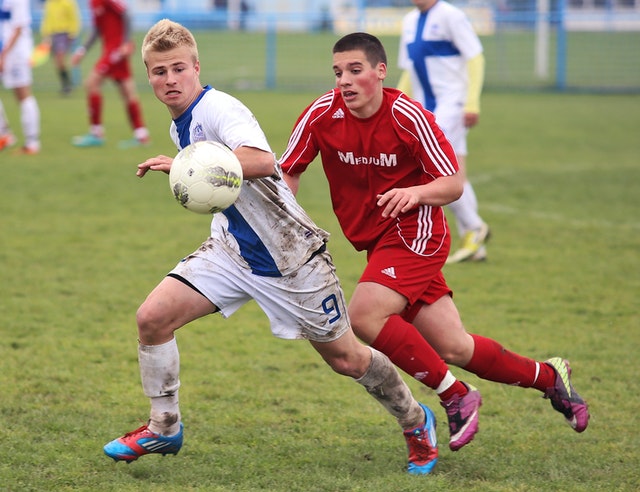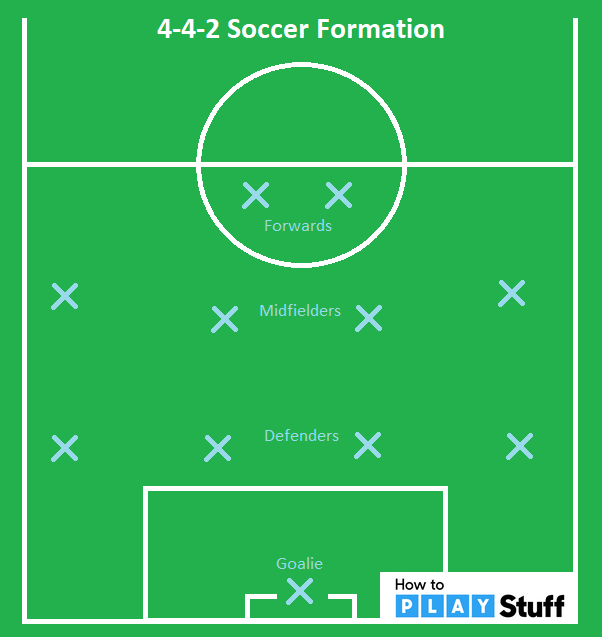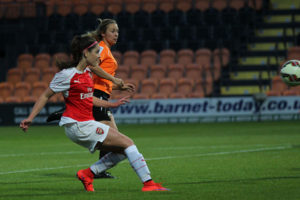
How to Play Soccer
Soccer Basics
- The object of soccer is to score on the opposing team’s goal while preventing them from scoring on your own team’s goal.
- Soccer is played with 2 teams of 11 players. The team that has scored the most goals after time expires, wins the game.
- The game is 90 minutes, split into 2 halves of 45 minutes in length. Youth soccer will play for less time, usually 80 minutes.
- Players primarily use their feet to maneuver the ball down the field. They also use their head, chest, and thighs. The use of hands or arms is prohibited in soccer with the exception of goalies.
- Soccer fields are typically about 120 yards long and 75 yards wide with goals that are 24 feet wide and 8 feet high.
- Soccer is nicknamed “the world’s game” because it is the most popular sport in the world.
If you want to know how to play soccer, you’ll need to know all the rules.
If the ball goes outside one of the boundary lines on the sides of the field, or the touch line (as it’s known in soccer), the team who didn’t touch it most previously is given a throw-in.
In a throw-in, a player must throw the ball into play by tossing it from behind his/her neck, straight over the top of his/her head with both arms from where the ball went out of touch. The player must also keep at least one foot down on the ground during the entirety of the throw-in. If not, the referee can call a “bad throw” which gives the ball to the opposing team.
When the ball goes outside the boundary line on the either end of the field (end line), the referee will either call a goal kick or a corner kick. If the defending team last touches the ball before it goes out of their own endline, a corner kick is given. If the attacking team last touches the ball (typically shooting on goal but missing) before going outside the endline, a goal kick is given.
A goal kick is usually taken by the goalie. The ball must be set down on the 6-yard line and then kicked down the field towards his/her team’s goal.
A corner kick is taken from the corner of the field near the goal by the attacking team. These are great scoring opportunities and where you’ll most-often see header goals.
There are many types of physical contacts that are prohibited in soccer which will result in a foul. This includes any type of violent attack, pushing, slide tackling without touching the ball first, grabbing, or shielding/blocking away from the ball. Shoulder-to-shoulder contact and bumping is allowed when those players are battling for possession of the ball. When a foul is called, a free kick is given. When a foul is called in the 18-yard box against the defending team, a penalty kick is given.
It the referee calls a penalty kick (PK), the ball is set down 12 yards (11 meters) from the offending team’s goal. All players except for the PK kicker and the goalie must line up outside the 18 yard box and stay outside of it until the kick is taken. Once the referee blows his/her whistle, the kicker shoots the ball with only the goalie to stop it. The goalie must stay on the goal line until the ball is kicked. Most penalty kicks are scored and teams are typically very unhappy with missed PKs. The only other way PKs are given are as a tiebreakers at the end of playoff matches.
Ejections (which is a removal of a player permanently from that game) and warnings are signified by using cards. A yellow card is a risen by the referee towards a player that has either committed an accumulation of fouls, a semi-violent foul, or an intentional foul in a goal-scoring opportunity. This is just a warning. A red card is risen by the referee towards a player that has either committed his/her 2nd yellow card offence, a very violent foul, a blatant intentional foul, or an intentional handball in his/her 18 yard box. A red card results in that player getting removed (ejected) from the match. Typically, a player that is given a red card will also be suspended for the following match. Red and yellow cards are used by referees in order to maintain order in a match.
Offsides in Soccer:
The most misunderstood and confusing rule in soccer is offsides. What is offsides in soccer? The ball cannot be passed to a teammate that is, at that moment, standing offsides. A player is standing offsides if he/she is beyond the furthest-back defender of the opposing team. If a pass is made towards a player that is standing/running beyond the furthest-back defender, the ref should call offsides and award a free kick to the opposing team. This rule alone is the main reason there are sideline refs, also known as assistant refs (ARs). The offsides rule prevents teams from keeping players way down the offensive side of the field to pass (or “boot it”) to. The offsides rules doesn’t apply to players that haven’t crossed the midfield line yet. It also doesn’t apply in throw-ins or corner kicks.
If you want to quickly know how to play soccer, you’ll need to know all the positions.
The Different Positions in Soccer:
Goalie: There is 1 designated goalie per team and they are positioned in front of their team’s goal. The goalie is the last line of defense before their goal and they are the only players on the field that can use their hands. They may only use their hands within their 18 yard box and as long as a teammate hasn’t intentionally passed the ball back to them with their feet. A goalie will be awarded a “clean sheet” stat if he/she doesn’t allow a single goal within an entire match.
Defenders: Defenders are arranged in front of the goalie but behind their midfielders. There are outside defenders and middle defenders. They are also known as “backs“. A center defender can also be called a sweeper. Defenders are responsible for preventing goals, slowing/stopping attacks, and gaining possession of the ball from the opposing team. They should also have enough skills to safely pass the ball up field to their midfielders or forwards. Typically, outside defenders will also be pushed up the wing to be part of an offensive attack. Middle defenders should be strong and aggressive players while outside defenders should be able to run fast.
Midfielders: Midfielders are arranged between their defenders and their forwards. Since they have the widest range of responsibilities on the soccer pitch, midfielders should have a wide range of skills and strong soccer IQ. They need to be able to control the game and make smart decisions throughout. Midfielders are responsible for making great passes and helping in their team’s attack, but also retreat back to help their defenders during an opponent’s attack. Winning loose balls is also a key trait for midfielders. Outside midfielders, or wings, play on either side of the field and are usually an essential part of their team’s attack. Wings can be considered midflielders or forwards.
Forwards: Forwards are responsible for attacking and scoring goals. They are also known as strikers. They are arranged highest up the field and in front of their midfielders. Forwards will need to be creative dribblers and accurate shooters.
Soccer Formations:
Soccer formations refer to the way in which defenders, midfielders, and forwards are positioned across the field. They are usually described as a series of numbers, starting with the amount of defenders, then midflielders, then forwards. The most common formation in 11v11 soccer is the 4-4-2. The diagram below shows a 4-4-2 soccer formation.

Soccer Equipment: players will need proper shoes (soccer cleats), shin guards, soccer socks to cover shin guards, and a jersey. Goalies will need goalie gloves and typically wear long sleeves with pants.
Hopefully this guide gave you a better understanding of how to play soccer. If you are looking to improve your skills, check out theses resources:
https://www.active.com/soccer/articles/improve-your-technical-soccer-skills

